Honda:
Manuals for repair and maintenance of Japanese motorcycles Honda VTX series
See this section in russian language
In this section of our website you will find a detailed guide to the operation, maintenance and repair of heavy Japanese motorcycles "Honda VTX1800C" on your own in a garage.
Description and history of Japanese motorcycles Honda VTX
| Content: | VTX1800 VTX1300 |
The Honda VTX series represents a collection of V-twin cruiser motorcycles crafted by Honda, drawing inspiration from the Zodia concept unveiled at the 1995 Tokyo Motor Show. The flagship model, the Honda VTX 1800, was introduced in 2001 as part of the 2002 lineup. Upon its launch, the VTX engine boasted the largest displacement of any production V-twin motorcycle globally, a title it held briefly until the Kawasaki Vulcan 2000 emerged in 2004. Despite this, the VTX 1800 continued to excel in performance, achieving superior 0-60 mph and quarter-mile times.
The acronym VTX signifies V-Twin eXtreme. In 2003, Honda expanded the lineup with the VTX1300 series, which transitioned into the VT1300C series beginning with the 2010 models.
Both the 1800 and 1300 models share several engineering features, including:
- A radiator equipped with a cooling fan
- Cylinder heads featuring two intake valves and a single, larger exhaust valve
- Rocker arms with screw-and-locknut adjusters for clearance
- An electronic control unit utilizing 3-D ignition maps for each cylinder
- Two spark plugs per cylinder
- A dry sump oil system with the oil reservoir integrated into the gearbox case
- A shaft final drive
VTX1800 (2001-2009)
In a bid to rectify years of underwhelming V-twin offerings, Honda aimed to create a cruiser with an unprecedented engine displacement. The VTX1800 was designed with a robust, elongated body that sat low to the ground, featuring a notable rake and trail. Honda claimed the 1800 produced an impressive 159 N⋅m of torque at just 3000 rpm and 75 kW (101 hp) at 5000 rpm, positioning the VTX1800 as one of the most potent production V-twin motorcycles of its era.
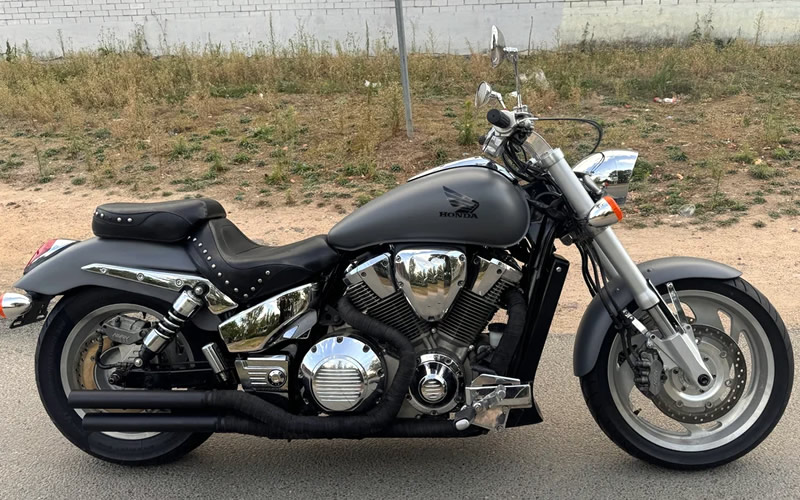
VTX 1800, 2003 year, right view
The VTX1800 featured an updated linked braking system, where the hand brake controlled two-thirds of the front pistons while the foot brake engaged the remaining front piston and all rear brakes via a proportioning valve. Its induction system utilized Honda's programmed fuel injection (PGM-FI), initially using a manifold air pressure (MAP) sensor in lower throttle ranges before switching to a standard throttle position sensor (Alpha N) at higher openings. Additionally, the VTX1800 was equipped with an emissions control system that included air injection and a catalytic converter managed by the ECU, ensuring compliance with stringent emissions regulations.
The 52-degree V-twin engine employed an offset dual-pin crankshaft — a design first seen in the 1983 Honda Shadow — allowing for optimal primary balance, complemented by two counterbalancer weights mounted on the primary shaft to mitigate vibration.

VTX 1800, 2002 year, left view
The initial 2002 lineup included three models: the VTX1800C Classic and two Retro variants — the VTX1800R with cast wheels and the VTX1800S with spoked wheels and tube-type tires. When launched, the VTX1800C was simply referred to as the VTX. Honda promptly announced the importation of the American-manufactured VTX1800 cruiser to their domestic market.
Distinctive features of the VTX1800C included a two-into-one exhaust system and a speedometer integrated within the handlebar risers, while the Retro models showcased staggered dual exhausts and a tank-mounted speedometer, alongside a larger radiator.
By late 2003, VTX1800 sales were nearing 30,000 units. A new model, the VTX1800N, was introduced for the 2004 model year, drawing design inspiration from the limited edition Valkyrie Rune.
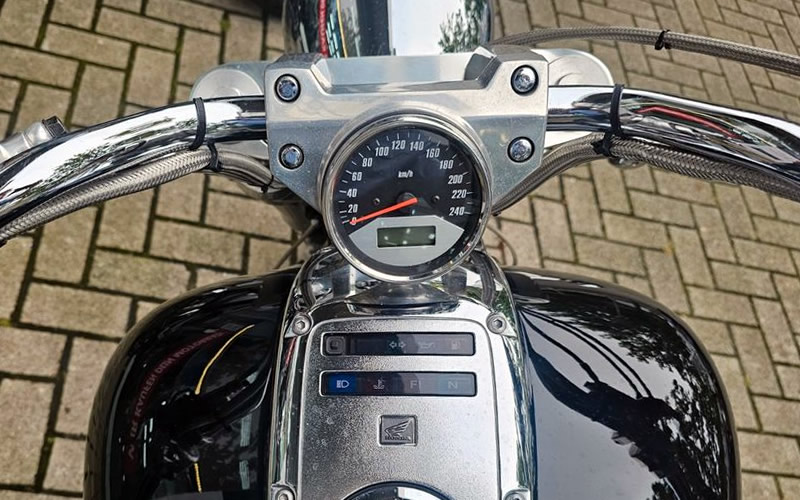
VTX 1800, 2004 year, dashboard
In 2005, Honda introduced the performance-oriented VTX1800F model, featuring low-profile radial tires on a five twin-spoke cast alloy wheel design, along with an LCD tachometer and clock integrated into the tank-mounted speedometer. This model played a significant role in defining the Performance Cruiser segment, competing against rivals such as the Yamaha Warrior, Victory Hammer, Kawasaki Mean Streak, and Harley-Davidson Street Rod.
The VTX1800T Tourer, equipped with 24-liter saddlebags, a windshield, and a passenger backrest, was added to the lineup in 2007. The VTX1800 series concluded its run in 2008, available in three variants: VTX1800N, VTX1800S, and VTX1800T.
VTX1300 (2002-2009)
In 2002, Honda introduced the VTX1300S as a 2003 model, featuring an all-new 1312 cc liquid-cooled V-twin engine producing 57-60 hp, all wrapped in classic cruiser styling and rolling on spoked wheels. The model quickly gained popularity, with sales reaching nearly 12,000 units by the end of 2003.
Unlike the VTX1800 line, the VTX1300 utilized standard unlinked brakes, featuring a single large 336 mm front disc and a 296 mm rear disc.
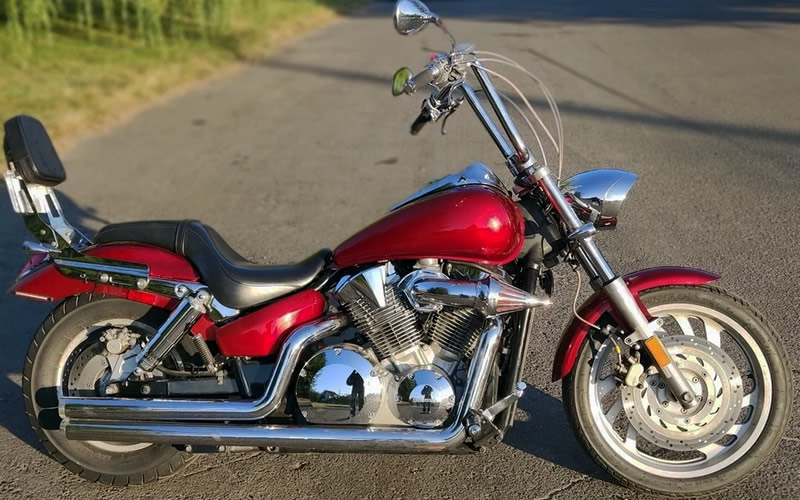
VTX 1300, 2008 year, right view
While the VTX1300 bore similarities to its larger counterpart, it was not merely a scaled-down version of the 1800 engine; rather, it was a completely new design. The 1300 engine was equipped with a 38 mm constant velocity carburetor, in contrast to the fuel injection system of the 1800. This single carburetor came with a manual choke for cold starts and was heated by engine coolant for improved performance in colder weather. The engine layout mirrored the liquid-cooled overhead-cam 52-degree V-twin design of the VTX1800, yet it featured a single-pin crankshaft as opposed to the dual-pin configuration of the 1800. Consequently, the 1300 required dual two-axis primary counterbalancers to manage engine vibrations. Additionally, the VTX1300 utilized a cable-operated clutch instead of the hydraulic clutch found in the 1800, and it incorporated an air injection system and catalytic converters to control emissions, similar to the larger engine.
The VTX1300 line maintained a consistent two-into-two exhaust system across all models, unlike the model-specific two-into-one system of the VTX1800C. In a road test by Motorcycle USA, editor Ken Hutchison noted that the VTX1300C had a muted exhaust note that might appeal to some but detracted from the traditional V-twin experience many buyers sought. Conversely, Motorcyclist magazine's Art Friedman praised the VTX1300 for its classic V-twin sound, more responsive handling, and smoother drivetrain compared to its 1800cc counterpart.
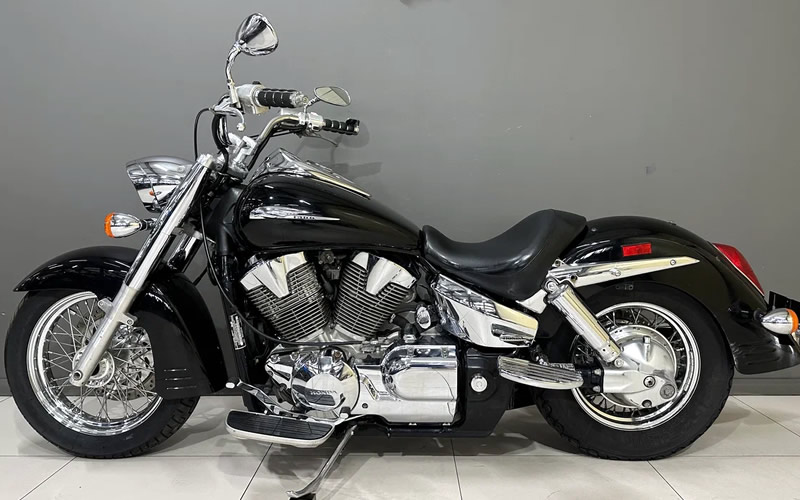
VTX 1300, 2004 year, left view
Instrumentation on the VTX1300 was minimal, featuring a large analog speedometer with a digital odometer housed in a nacelle atop the fuel tank, devoid of additional gauges like a clock or fuel indicator. The 2004 VTX1300S was soon joined by the lighter and shorter VTX1300C Custom, which sported cast-alloy wheels, a drag-style handlebar, and lacked the floorboards and heel-and-toe shifter found on the S model. The C model also enjoyed strong sales, exceeding 11000 units in its first year.
The VTX1300 family expanded in 2005 with the introduction of the VTX1300R Retro, which combined classic cruiser aesthetics with cast-alloy wheels and tubeless tires, mirroring the VTX1300S otherwise. The R model also performed well in sales, with over 8,000 units sold in its inaugural year. Honda continued to offer the C, S, and R models through 2006 and 2007, primarily altering the paint schemes.
In 2008, Honda discontinued the spoked-wheel VTX1300S but retained a three-model lineup by adding the VTX1300T Tourer variant, which featured cast wheels. The Tourer was essentially a type R model, factory-equipped with the three most popular accessories: 24-liter saddlebags, a windshield, and a passenger backrest. In a road test by the Los Angeles Times, Susan Carpenter described the VTX1300T as a "Midwesterner's motorcycle," highlighting its popularity in rural regions.
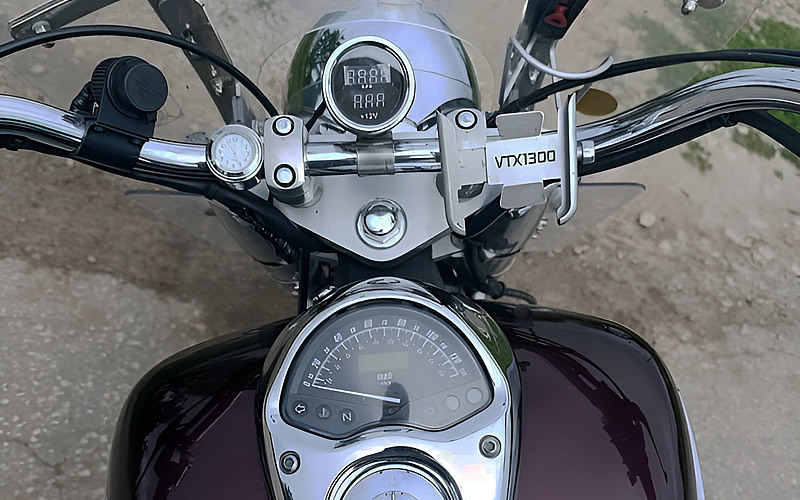
VTX 1300, 2007 year, dashboard
For 2008, the two-into-two exhaust system underwent redesign for a more compact form. The VTX1300's final year was 2009, with the C, R, and T models available in fresh colors but otherwise identical to the previous year.
Competing models included Yamaha DragStar 1100 (also known as V Star 1100), V Star 1300, Suzuki Boulevard S83, Harley-Davidson Sportster 1200 Custom, and Kawasaki Vulcan 900 Classic and 1500 Classic.
Overall, total sales for all VTX1300 cruiser models reached an impressive 82900 units across all production years.
- Information for owner
- Control devices
- Operation manual
- Maintenance
- Engine and systems
- Engine repair
- Fuel and control system
- Cooling system
- Lube system
- Transmission
- Running gear and frame
- Frame and hinged elements
- Front suspension and handlebar
- Rear suspension
- Brake system
- Electric equipment
- Equipment and devices
- Ignition system
- Starting and charging system
